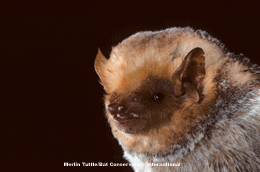Animal Fact Sheet: Western red bat |
Identifying Features The western red bat (Lasirurs blossevillii) is considered by many to be one of the more beautiful bat species. Its dense shaggy fur ranges from brownish-yellow to an almost bright orange with white hair tips and white fur on its neck. The wing membranes are black and the top of its tail membrane is furred. |
 |
Migration/Hibernation Studies of these bats indicate they migrate to the southern part of their range to hibernate. They are solitary by nature, but will gather in larger nursery roosts during the summer. |
Habitat Western red bats are solitary animals who prefer riparian areas dominated by walnuts, oaks, willows, cottonwoods, and sycamores where they roost in these broad-leafed trees. They roost only in tree foliage. |
Range These bats can be found in western Canada, the western United States, western Mexico and Central America. |
Wild Status Currently there is no proposal for listing this bat as threatened or endangered by the United States Fish and Wildlife Service. However, bat biologist are concerned that the loss of suitable riparian habitats are affecting the population and are keeping a close watch on this species. |
Diet The western red bat is an insectivore. When it emerges from it daytime roost it searches out primarily flying insects such as moths, flying ants and beetles. On occasion it will capture an insect on the ground. |
Predators Predators of these bats include falcons, scrub jays, owls, roadrunners, feral cats, raccoons and opossums. |
Reproduction Mating occurs in the fall. Sometime between May and late June the female will often give birth to twins. The pups begin flying at 3 to 4 weeks. |
Life Span The estimated life span of the western red bat is 12 years. |
Size Their weight is between 0.4-0.5 oz (10-15 g). Their wingspan is between 11-13 inches (28-32 cm). |
|
Extra Fun-facts
|










